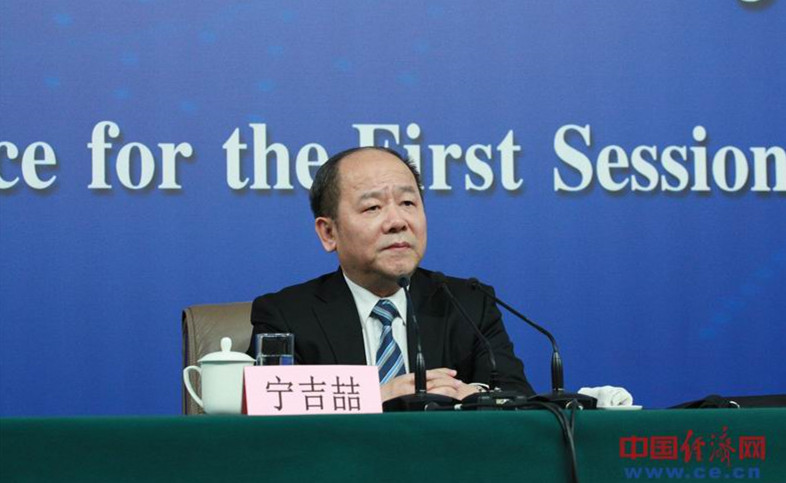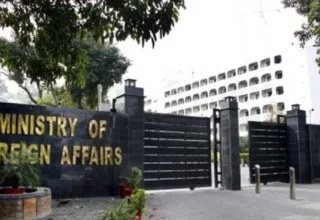
- Belt, Road joint development to follow market orientation, international practices: says NDRC Vice Chief
BEIJING – Ning Jizhe, vice-chairmen of the National Development and Reform Commission (NDRC), has said that the joint development of the Belt and Road will follow market orientation and international practices by giving full play to the guiding role of enterprise entities and governments, and that key tasks in the future will include vigorously expanding cooperation in third-party markets and increasing the support for people-to-people connectivity projects of the Belt and Road Initiative.
Mr. Ning made the above remarks during a recent press conference for the Second Session of the 13th National People’s Congress. He noted that in the past five years, important progress and remarkable achievements have been made in jointly building the Belt and Road, which is mainly reflected in the connectivity in five aspects:
First, in terms of policy connectivity, China has signed 171 cooperation documents with 123 countries and 29 international organizations, including developing and developed countries, international organizations, as well as companies and financial institutions of many developed countries, to jointly develop third-party markets.
Second, in terms of infrastructure connectivity, solid progress has been made in the development of China–Laos Railway, the China–Thailand Railway, the Jakarta–Bandung High-Speed Railway, and the Hungary–Serbia Railway. Last week, I went to the China–Laos Railway for research. A few days ago in Beijing, I invited the minister of transport of Thailand and the minister of transport of Laos to study the connection between the China–Laos Railway and the China-Thailand Railway. Smooth progress has been made in the Gwadar Port, the Hambantota Port, the Piraeus Port and the Khalifa Port. By the end of February this year, just a few days ago, the number of China–Europe freight trains had reached 14,000, not including those from China to Central Asia. Special sessions were held in this regard the other day.
Third, in terms of trade connectivity, China’s trade in goods with countries along the Belt and Road has exceeded 6 trillion US dollars in the past five years. Last year, China invested 15.6 billion US dollars in countries along the Belt and Road. Steady progress has been made in the China-Belarus Industrial Park, the China–UAE Industrial Capacity Cooperation Demonstration Zone, and the China–Egypt Suez Economic and Trade Cooperation Zone.
Fourth, in terms of financial connectivity, by the end of 2018, the loan balance of the China Development Bank and the Export-Import Bank of China in countries along the Belt and Road was about 250 billion US dollars. China Export & Credit Insurance Corporation has secured more than 600 billion US dollars of insurance coverage in countries along the Belt and Road. China has set up a capacity-building center together with the International Monetary Fund.
Fifth, in terms of people-to-people connectivity, a series of achievements have been made in scientific and technological exchanges, educational cooperation, cultural tourism, green development and foreign aid.
Mr. Ning said that jointly building the Belt and Road has not only promoted the economic development of the countries along the Belt and Road, increased employment, provided tax revenue, improved people’s livelihood and added high-quality assets, but also boosted the economic recovery and development of the relevant regions and even the world.
At present and for some time to come, the building of the Belt and Road is transiting from the planning stage to the stage of intensive work. In adherence to the principles of “collaboration, participation, and common interests” and “policy, infrastructure, trade, financial, and people-to-people connectivity,” we should follow market orientation and international practice, give full play to the leading role of enterprise entities and governments, and promote the high-quality development of the Belt and Road. We need to work together to:
Further build consensus on cooperation. We should steadily expand the scope of cooperation documents on jointly building the Belt and Road and jointly promote the early harvest of cooperation results. We will work together to successfully hold the Second Belt and Road Forum for International Cooperation in Beijing in late April this year. We will summarize the progress of past cooperation and anticipate vision of future cooperation.
Make solid progress in connectivity. We should not only strengthen connectivity in railways, highways, airports and ports, but also promote soft connectivity in policies, rules and standards. We need to open up not only land, marine and air Silk Road but also the digital Silk Road. We should work together to build both infrastructure and economic corridors.
Continue to strengthen international cooperation on production capacity. To meet the market needs of countries along the Belt and Road and other relevant regions, we should deepen investment cooperation, foster competitive industries, and enhance the economic strength of each country. China has set up a regularly updated list of capacity cooperation schemes together with Kazakhstan and Russia.
Vigorously expand cooperation in third-party markets. While strengthening bilateral cooperation with countries along the Belt and Road, we should promote third-party cooperation among enterprises from China, the countries where the investment is made, developed economies and other economies, so as to achieve mutual benefit and win-win results. For example, China has cooperated with France in the third-party markets in some Asian and African countries, China has cooperated with Singapore in the third-party markets in southeast Asian countries, and China and Japan have also started cooperation in Thailand.
Constantly enrich the content of cooperation. We should promote innovation in the “Belt and Road” cooperation scheme, model, platform and factor allocation, increase support for people-to-people connectivity projects of the Belt and Road Initiative, and build the Belt and Road into a road of peace, prosperity, openness, greenness, innovation, integrity and civilization.
Ning Jizhe currently serves as the Chinese chairman of the Joint Cooperation Committee for China–Pakistan Economic Corridor.








